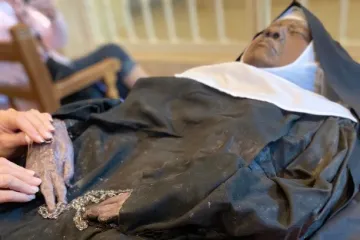CNA Newsroom, May 26, 2023 / 13:45 pm
Expert morticians are scratching their heads at the recently exhumed body of Sister Wilhelmina Lancaster, a Benedictine nun who died in 2019 and now appears to be in an unexpected state of preservation.
The reactions come a week after the abbess and sisters of the community that she founded, the Benedictine Sisters of Mary, Queen of the Apostles, unearthed the 95-year-old African American religious sister’s simple wooden coffin on April 28 from the cemetery on the monastery grounds in rural Gower, Missouri, to relocate her remains to a final resting place inside their chapel.
The local ordinary, Bishop Vann Johnston of the Diocese of Kansas City-St. Joseph, visited the monastery Monday to see Sister Wilhelmina’s remains. Johnston issued a statement the same day, saying that a “thorough investigation” was needed to answer “important questions” raised by the state of her body.
Jack Klein, owner of Hixson-Klein Funeral Home in Gower, Missouri, who said he was present at Sister Wilhelmina’s burial and issued her death certificate, confirmed for CNA that the religious sister’s body was not embalmed and that the wood coffin was not placed into any outer burial container.
Klein said he “can’t understand” how Sister Wilhelmina’s un-embalmed body is in the state it’s currently in, four years after her burial.
David Hess, program coordinator and associate professor in the mortuary science department at Salt Lake Community College in Salt Lake City, expressed similar surprise.
“If the body was not embalmed, and it was still intact after four years, that one kind of throws me,” he told CNA. “I would have expected the body to be decomposed, maybe not all the way down to bone, but at least severely decomposed.”
Sister Wilhelmina’s body, which has been on display in the open air for pilgrims to visit, is reported to have no foul odor in recent days, as would be the case, morticians say, with a body that has undergone decomposition for four years.
One pilgrim, Peggy Tynan of Denver, even told CNA that while praying over Sister Wilhelmina’s body on May 24, she smelt a “sweet and flowery aroma,” which was so powerful she could taste it. A journalist from EWTN’s ACI Group who visited the body last weekend also noticed no odor of decomposition.
“It’s kind of strange, if the body was not embalmed, that there would be no odor,” Hess said.

There has been no official determination that Sister Wilhelmina’s remains are incorrupt, nor is there any cause underway for her canonization, a formal process in the Catholic Church that can take many years. Her fellow sisters plan to hold a procession on Monday on the monastery grounds and then place Sister Wilhelmina’s body under a glass case to accommodate the many pilgrims coming to the property.
An open question is if and how the foundress’ remains will be scientifically analyzed. A diocesan spokeswoman, Ashlie Hand, told CNA on Wednesday that the diocese isn’t aware of any specific Church guidelines for how to conduct such an investigation.
Bishop Johnston is "definitely working on it and trying to find a careful process, a careful approach, that’s well thought through,” she said.
Hand said as many as 1,000 pilgrims reportedly visited the monastery on Wednesday. The diocese has been advising the sisters about how best to handle the influx of visitors, she said.
“The condition of the remains of Sister Wilhelmina Lancaster has understandably generated widespread interest and raised important questions. At the same time, it is important to protect the integrity of the mortal remains of Sister Wilhelmina to allow for a thorough investigation,” Johnston said in his statement.
(Story continues below)
“I invite all the faithful to continue praying during this time of investigation for God’s will in the lives of the Benedictines of Mary, Queen of Apostles; for all women religious; and all the baptized in our common vocation to holiness, with hope and trust in the Lord.”
No explanation yet
According to the sisters, at some point after the burial Sister Wilhelmina’s coffin sustained a crack down the middle that let in moisture and dirt. Her body was discovered to be covered in what the sisters described as a layer of mold after being exhumed.
CNA asked Hess and another expert about the possibility that the body might have been preserved through a chemical process called “grave wax.”
“Grave wax” is an uncommonly seen but natural phenomenon that encases a corpse or parts of a body in a shell of soap-like fatty tissue, called adipocere, which slows or stops the normal decomposition process, which can preserve the human remains for many years — even centuries.
Two so-called “soap mummies” — dubbed “Soap Lady” and “Soap Man” — were exhumed in 1875 during digging for the foundation of a train depot in downtown Philadelphia decades after they died.
“This unusual preservation occurred because water seeped into the casket and brought alkaline soil with it, turning the fats in his body to soap through a type of hydrolysis known as saponification,” according to the Smithsonian Institution, which has kept the man’s remains in climate-controlled storage in the Smithsonian’s Museum of Natural History in Washington, D.C. The woman’s remains are on exhibit in Philadelphia’s Mütter Museum.
Hess said that grave wax typically only materializes in different parts of the body, but he said it could cover the entire body. He added that grave wax will break down over time.
Hess said that he “highly” doubts that grave wax could have preserved Sister Wilhelmina’s body to appear the way it currently does and without any foul odor, “unless she was in a highly alkaline environment.”
Mortician Barry Lease, president and CEO of the Pittsburgh Institute of Mortuary Science, told CNA that a soil analysis testing the pH, or point hydrogen, of the environment, would reveal whether Sister Wilhelmina’s former burial grounds are highly alkaline. According to the Mütter Museum, “Adipocere formation is not common, but it may form in alkaline, warm, airless environments, such as the one in which the Soap Lady was buried.”
Lease said that it’s difficult to project where the body would be in the decomposition process if it was covered in adipocere but added that the body’s decomposition “should be further than that,” referring to a photo of the body taken by CNA on May 20.
“You shouldn’t be recognizing her with just a little bit of mold on her face,” Lease said.
“An unembalmed body in the ground for four years should have some odor coming off of it that would be noticeable,” he added.
“If you’re telling me that this woman went into the ground unembalmed in a wooden box with no outer container in the ground and it was not sub-zero up in Alaska, I’m telling you, I’m going to start a devotion to this sister, because something special is going on there,” Lease, a practicing Catholic, told CNA.
Editor's note: This story was updated on June 2 to correct the date that Sister Wilhelmina's body was exhumed.








